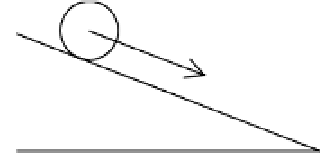Game Development Reference
In-Depth Information
mgsinθ
F
f
θ
Figure 4-13.
An object rolling down a ramp has both translational and rotational motion.
As the object rolls down the ramp, it experiences both translational and rotational motion.
If the object is symmetrical and has a uniform material distribution, the center of mass will be
located in the center of the object, and as the object rolls down the ramp, the center of mass
moves in a straight line parallel to the face of the ramp. As the object rolls down the ramp, every
part of the object is rotating about an axis of rotation that extends lengthwise through the object
and passes through the center of mass. There is a gravitational force that pulls the center of
mass down the ramp, and there is a frictional force where the surfaces of the object and the
ramp meet that acts in the opposite direction.
If the object rolls without slipping, the center of mass will move a distance of 2
pr
, where
r
is the radius of the object for every rotation of the object. If the angular velocity of the object is
w
, the time it takes to complete one revolution is equal to 2
p/w
. Therefore, the velocity of the
center of mass of the object as it rolls down the ramp is equal to the distance traveled per rotation
divided by the time to complete one rotation.
2
pr
2
p
w
v
=
------------
=
wr
(4.33)
⎝
⎛⎞
------
The expression shown in Equation (4.33) is the same as Equation (4.30) derived earlier in
this chapter. It states that the velocity of the center of mass of an object that is rolling without
slipping is equal to the angular velocity of the object multiplied by the radius of the object. The
angular and translational accelerations for a nonslipping, rolling object can be related by a
similar expression.
a a
=
(4.34)
Now let's turn our attention to deriving expressions for the translational and angular
velocity of a rolling object. The component of gravitational force that acts parallel to the ramp
is equal to
mg
sin
q
. There will also be a force due to friction acting in the opposite direction to
the parallel component of the gravitational force. Because the friction force acts on the outer
surface of the object, it creates a torque about the axis of rotation with a value of
t
=
F
f
r
. This
torque causes the object to rotate according to Equation (4.32).
When the object begins to roll down the ramp, the center of mass of the object undergoes
a translational acceleration that is proportional to the net force on the object in the direction
parallel to the face of the ramp.
mg
sin
q
−=
F
ma
(4.35)
f




